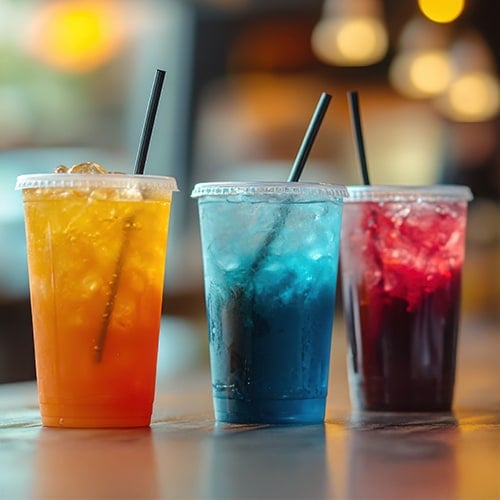Top Coffee and Tea Trends of 2026
Last updated on Nov 12, 2025Corrinn McCauleyCoffee and tea have long been staples in the foodservice sector, with coffee alone accounting for 8% of the U.S. foodservice industry, according to the NCA 2023 economic impact report. In the United States, coffee remains more popular than tea, but globally, tea is the second-most-consumed beverage, behind packaged water. In our increasingly globalized society, where trends spread rapidly through platforms like TikTok, the tea market is experiencing a surge in popularity in the American market. As operators in the coffee and tea industry, it is crucial to stay ahead of the curve and adapt to evolving consumer demands. Guided by our insider industry insight and research into current foodservice statistics, we reveal the top 10 trends in the coffee and tea industry that operators should take note of to ensure they are meeting the changing preferences of their customers.

Protein Coffee
Consumers are looking for a boost of protein with their morning caffeine fix, leading to the rise of protein coffee. According to an Aromatech study, the protein coffee market will hit $14.7 billion by 2034. While you can add protein powder directly to your coffee drinks, baristas are finding creative ways to give a protein boost, such as creating protein-infused milk for lattes and protein cold foam. Popular brands like Starbucks and Jimmy’s Coffee have hopped onto the trend, and smaller businesses would do well to adopt protein into their drinks to keep up with their larger competitors. To stand out, use protein with clean labels, offer plant-based protein options, and source protein with additional benefits like whey with colostrum to attract health-conscious consumers.

Houjicha
As matcha continues to rise in popularity, sourcing has become increasingly challenging. However, the solution may lie in houjicha. Made by roasting green tea leaves, houjicha offers a distinctive nutty flavor, caramel-like aroma, and a reddish-brown color that sets it apart from other green teas. It can be served hot or cold, making it suitable for various commercial applications such as cafes, restaurants, and tea shops. One of hojicha's biggest strengths in the 2026 market is its simplicity and traceability. With just tea leaves and fire-roasting, it checks all the boxes for consumers seeking transparency and low-intervention ingredients. While matcha isn’t going anywhere, houjicha is an emerging way to enjoy the benefits of green tea at a lower price tag and easier sourcing methods.

Amped Up Loaded Teas
Not your traditional tea, loaded teas are a mix of energy drink-like ingredients packed with stimulants like caffeine, guarana, and ginseng, as well as vitamins, herbal extracts, and sugar substitutes. Since these beverages appeal to health-conscious and active consumers, choose options like monk fruit, allulose, and stevia over artificial sweeteners like aspartame. Businesses can charge extra for added vitamins, collagen, and creatine, and offer customization options for caffeine levels (regular, half, or extra). Carbonation can also be an additional upcharge for those seeking a fizzy kick. Perfect for fitness-focused markets, consider partnering with local athletic events and setting up a well-stocked stand to sell loaded teas to participants as a pre-workout drink. Maximize your time at these events by passing out freebies to raise brand awareness and increase loyalty.

Emerging Unique Flavors
You don’t have to reinvent the wheel to keep up with consumer preferences; you can add trending flavors to your existing menu. One niche flavor gaining traction in 2026 is red fruit, a delicacy enjoyed in Papua New Guinea and Indonesia, prized for its antioxidants. Other exotic fruits gaining traction are yuzu and elderberry. Baristas are even playing with savory flavors, with "spring onion coffee" trending on TikTok. Largely thanks to Dubai chocolate creations, pistachio is having a moment, so offer pistachio milk as a dairy milk alternative. Earthy flavors like pine, juniper, and sage will add depth and grounding notes. Syrups are an easy way to incorporate these flavors, but you can get creative by using them as toppings, either whole or in a dehydrated powder form. If the flavor's appeal is its health benefits, market them on your menu (for example: "immunity-boosting elderberry tea".

Premium Lattes
Consumers want coffee drinks that feel like affordable luxuries with decadent ingredients, interesting textures, and visual appeal. Consider the viral iced cloud latte, which mimics the appearance and texture of a fluffy cloud, and the trending creme brulee latte with a caramelized sugar topping. 2026 will feature globally inspired lattes such as horchata lattes, inspired by the beloved Mexican rice-milk beverage. The classic coffee-enriched Italian dessert, tiramisu, makes for the perfect gourmet latte, combining the decadent flavors of cinnamon and rum with a protein-rich mascarpone steamed milk. Dubai chocolate has taken the internet by storm, and it’s now taking over coffee shop menus with Dubai chocolate drinks inspired by the viral pistachio chocolate bar. From a Dubai chocolate mocha to a cold brew infused with chocolate syrup, topped with pistachio cold foam, and a sprinkle of crispy kataifi.

Clean, Transparent Labeling
Seeking transparency and healthier options, consumers are paying more for items with clean label claims such as natural, organic, and no additives/preservatives. According to an Innova Market Insights report, 30% of global food and beverage launches featured a clean label claim in the past year. Additionally, around 30% of consumers are actively reducing their processed food consumption, and 27% making efforts to limit products or ingredients perceived as unhealthy. This includes a focus on avoiding artificial preservatives, sweeteners, and additives. Among clean label claims, no additives or preservatives lead the pack with a 14% penetration rate, followed by organic, natural, and GMO-free claims. Notably, ethical-environment claims have shown the fastest growth, with a 15% compound annual growth rate (CAGR) over the past five years, confirming a shift towards environmental values and concerns.

High Tea
Platforms like Pinterest have seen a staggering 165% increase in searches for "afternoon tea party ideas," and the hashtag #afternoontea garnered an impressive 182.3k posts on TikTok. Businesses can tap into the growing demand by offering a high tea menu alongside or in place of traditional brunch offerings. To stand out from the crowd, mix classic British high tea elements with modern innovations. Think unique teas like butterfly pea tea and trendy takes on traditional British bakes like swapping lemon for yuzu in lemon drizzle cake. The broader cultural shift towards experience-based dining and non-alcoholic social options is fueling the high tea revival. Whether patrons are avoiding booze entirely or choosing not to drink on weeknights, afternoon tea can serve as an alternative happy hour, allowing people to socialize with pretty beverages and light bites without social pressure to consume alcohol.

Coffee Shop Oasis
With the ongoing stresses of daily life, Millennials and Gen Z are increasingly seeking spaces to escape the daily grind and enjoy affordable indulgences. This is where the rise of cafe culture meets the trend of treat culture. To cater to this demographic and create a coffee shop oasis, invest in comfortable seating options such as plush armchairs, cozy couches, and cushioned bar stools. Set up different seating zones to cater to various preferences, from communal tables for socializing to cozy nooks for those seeking solitude. Opt for a mix of natural light and warm, soft lighting to create an inviting atmosphere. Consider using pendant lights, table lamps, and wall sconces to add visual interest. Use essential oil diffusers or scented candles to fill your space with inviting fragrances. Consider working with a local candle maker to develop a signature scent for your storefront and sell it as part of your merchandising efforts.

Decaf Coffee
As consumers are becoming more conscious of the potential health risks associated with caffeine consumption, the popularity of decaf coffee is growing. The global decaf coffee market size is projected to reach USD 28.98 billion by 2032, according to a SkyQuest study. Decaffeinated coffee is produced by removing 97% of the caffeine from coffee beans before they are roasted and ground. This process allows coffee lovers to savor the rich flavors and aromas of coffee without the jitters or sleep disturbances associated with caffeine consumption while retaining the antioxidants and perceived health benefits of coffee beans. Coffee shops can stay ahead of this trend by broadening their decaf coffee options. Coffee roasteries that develop decaf options that taste identical to their regular coffee beans will gain a market edge.

Merged and Remodeled Cafes
Coffee is now intertwined with various industries, and cafes are incorporating additional services. Think a yoga studio with a tea bar or a coffee/floral shop hybrid where patrons can create their own bouquets or place floral arrangement orders while sipping their latte. Cafes located in fitness-focused communities are introducing supplement offerings like creatine, collagen, and adaptogen add-ins, and then offering to serve as the start and end point of weekly run clubs so participants can recharge and connect over superfood drinks. Themed cafes, art galleries, and spaces for live performances are becoming increasingly popular, blending coffee culture and entertainment. Beyond adding other business types and hosting events, coffee shops are developing merchandising lines to promote their cafe and foster brand loyalty among customers.
What Is Driving Coffee and Tea Trends 2026?
The coffee and tea industry is constantly evolving, driven by a multitude of factors that shape consumer preferences and industry trends. As we look ahead to 2026, several key influences are shaping the trajectory of the coffee industry and tea businesses in 2026 and beyond.
- Artificial Intelligence (AI): From automated brewing systems to personalized recommendations based on consumer preferences, AI is reshaping the way businesses operate and interact with their customers. It’s improving the production process by creating algorithms that hone roasting techniques for enhanced flavor profiles. AI is also streamlining coffee production by optimizing supply chain logistics and automating repetitive tasks.
- Sustainability Practices: No longer a preference, sustainability is now expected. Consumers demand ethically sourced products, eco-friendly packaging, and transparent supply chains. Companies that prioritize sustainability are not only meeting consumer expectations but also contributing to a greener future for the industry.
- Social Media: In the digital age, social media plays a crucial role in shaping consumer preferences and driving industry trends. Coffee and tea businesses are utilizing platforms like Instagram, Facebook, and TikTok to showcase their products , engage with customers, and create buzz around new offerings. Social media influencers and user-generated content are also guiding purchasing decisions, making it essential for businesses to have a strong online presence.
- Treat Culture: Consumers are looking for "little treats" to spark joy in their day. Treat culture emphasizes the importance of presentation, quality ingredients, and innovative flavors to enhance the overall customer experience. This trend is driving demand for premium drinks, flavored syrups, and artisanal blends. It also includes the rise of gourmet pastries, artisanal chocolates, and specialty snacks that complement coffee and tea offerings.
- Texture Stimulation: With consumers' increasingly short attention spans, creating texturally engaging beverages is helping capture and retain their attention. From fluffy cold foam to crunchy toppings, coffee shops are experimenting with different consistencies to create sensory experiences that stand out in an oversaturated and overstimulated market.
2026 is an exciting time to become a coffee shop owner. AI technology is advancing to upgrade your processes at every step of sourcing, production, and service. The public desire for indulgent drinks swings the doors of creative menu innovation wide open. The opportunity to create hybrid businesses and partner with other entrepreneurs both lightens the load and breathes new life into your business model. Whether you're integrating new trends into your existing cafe or starting a new concept, use this blog as a springboard to your ongoing success.








